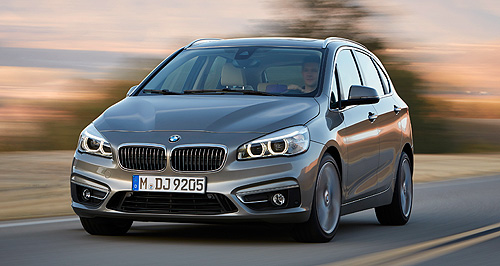Front first: BMW’s new 2 Series Active Tourer is the company’s first mass-produced car with front-wheel drive and a three-cylinder engine.
Gallery

Click to see larger images
BMW’S answer to the Mercedes-Benz B-Class, the front-wheel-drive 2 Series Active Tourer, will launch with a choice of three turbocharged engines, including the first three-cylinder sold under the propeller badge.
Scheduled to land in Australian showrooms in about September or October this year, the five-seat compact wagon will make its public debut at next month’s Geneva motor show – 18 months after the car was shown in concept form at the 2012 Paris motor show.
The vehicle marks a big break with tradition for BMW which has shed its rear-drive heritage in this model in the interests of fuel economy, cost savings and keeping up with the Joneses in Stuttgart and Ingolstadt.
The wagon is the second model to carry the new 2 Series badge, following in the wheeltracks of the rear-drive 2 Series Coupe.
The new model is expected to become one of BMW’s biggest sellers, hitting back at Mercedes-Benz and Audi which have taken a sizeable lead in front-drive luxury compact cars.
At 4342mm long, the 2 Series Active Tourer is 17mm shorter than the B-Class but 14mm wider, at 1800mm. While the BMW is 1586mm tall, the Benz is 1557mm.
The Active Tourer sits on a 2670mm wheelbase – 19mm shorter than the spread of the B-Class. Its all-new platform is BMW’s new UKL1 vehicle architecture that also carries the new-generation Mini due in Australia this year.
Those two vehicles also share the new three-cylinder engine, a form of which will also help to power the Munich brand’s plug-in hybrid i8 sports-car that is also due down under in 2014.
Developing 100kW at 4500rpm and 220Nm of torque at 1250rpm, the transverse-mounted 1.5-litre turbocharged petrol engine will power the entry level 218i Active Tourer. Other models at launch will be the 170kW/350Nm 2.0-litre petrol four-cylinder 225i and 110kW/330Nm 2.0-litre diesel 218i.
The pint-sized engine propels the 1320kg 218i to 100km/h in 9.3 seconds and on to a top speed of 200km/h.
According to unofficial European fuel tests, the 218i Active Tourer consumes 4.9 litres per 100km, while emitting just 115 grams of CO2 per kilometre.
The diesel 218d is both faster and more fuel efficient that the 218i, returning a combined fuel figure of 4.1L/100km and acceleration from zero to 100km/h in 8.9 seconds.
The 225i, which will fill the role of the performance flagship until something hotter comes along, uses 6.0L/100km and can hit the 100km/h mark in 6.8 seconds.
Fuel-saving technologies include idle stop, brake energy regeneration, a gearshift indicator, on-demand operation of ancillary units and an ‘air curtain’ that has two vertical air inlets in the front bumper to direct the airstream along the front wheels.
While the three-cylinder engine drives the front wheels via a choice of six-speed manual or automatic gearboxes, the 225i uses an eight-speed automatic, while the diesel variant comes with a six-speed manual or optional eight-speed auto.
The diesel is said to be a new member of the same family as its three- and four-cylinder petrol counterparts.
Like the rival B-Class, the Active Tourer’s main attraction will be its high-roofed spaciousness for families and versatile load capability.
The boot carries 468 litres with the rear-seat up, growing to 1510 litres with the seat folded. That seat can slide to provide more kneeroom or luggage space, and splits three ways – 40:20:40.
The rear hatch can be fitted with an optional push-button closer or ‘Smart Opener’ foot-wave closing mechanism. A panoramic sunroof is also on the options list.
The Active Tourer rides on a single-joint spring strut axle at the front and a multi-link rear axle, which BMW says combines “agility and directional precision with excellent handling stability and suspension comfort”.
The company also says its electromechanical steering has been specially tuned for driver feedback, and works in conjunction with the front drive system to eliminate torque steer.
Sixteen-inch alloy wheels are standard on the 218i and 218d, while the 225i gets bigger 17-inch rims with 55-section tyres.
For the driver, a head-up display is optional, with BMW claiming this is a first in the class.
Another option in some markets – and yet to be confirmed for Australia – the concierge service, in which the driver can call a BMW centre to ask for information such as the nearest ATM or chemist.


 Alfa Romeo
Alfa Romeo Abarth
Abarth Audi
Audi Aston Martin
Aston Martin BMW
BMW Bentley
Bentley Chrysler
Chrysler Chevrolet
Chevrolet Dodge
Dodge Citroen
Citroen Ferrari
Ferrari DS
DS Ford
Ford Fiat
Fiat FPV
FPV Foton
Foton Haval
Haval Great Wall
Great Wall Honda
Honda Holden
Holden Hyundai
Hyundai HSV
HSV Isuzu
Isuzu Infiniti
Infiniti Jeep
Jeep Jaguar
Jaguar Lamborghini
Lamborghini Kia
Kia Lexus
Lexus Land Rover
Land Rover Mazda
Mazda Maserati
Maserati Mercedes-Benz
Mercedes-Benz McLaren
McLaren Mini
Mini Nissan
Nissan Mitsubishi
Mitsubishi Peugeot
Peugeot Opel
Opel Proton
Proton Porsche
Porsche Renault
Renault Ram
Ram Saab
Saab Rolls-Royce
Rolls-Royce Smart
Smart Skoda
Skoda Subaru
Subaru SsangYong
SsangYong Tesla
Tesla Suzuki
Suzuki Toyota
Toyota Volvo
Volvo Alfa Romeo
Alfa Romeo Abarth
Abarth Audi
Audi Aston Martin
Aston Martin BMW
BMW Bentley
Bentley Chrysler
Chrysler Chevrolet
Chevrolet Dodge
Dodge Citroen
Citroen Ferrari
Ferrari DS
DS Ford
Ford Fiat
Fiat FPV
FPV Foton
Foton Haval
Haval Great Wall
Great Wall Honda
Honda Holden
Holden Hyundai
Hyundai HSV
HSV Isuzu
Isuzu Infiniti
Infiniti Jeep
Jeep Jaguar
Jaguar Lamborghini
Lamborghini Kia
Kia Lexus
Lexus Land Rover
Land Rover Mazda
Mazda Maserati
Maserati Mercedes-Benz
Mercedes-Benz McLaren
McLaren Mini
Mini Nissan
Nissan Mitsubishi
Mitsubishi Peugeot
Peugeot Opel
Opel Proton
Proton Porsche
Porsche Renault
Renault Ram
Ram Saab
Saab Rolls-Royce
Rolls-Royce Smart
Smart Skoda
Skoda Subaru
Subaru SsangYong
SsangYong Tesla
Tesla Suzuki
Suzuki Toyota
Toyota Volvo
Volvo





































Facebook Twitter Instagram